

Journal Article. Good vibrations: What Earthquakes can tell us about the Earth - Science Over Everything. Next Generation Science Standards: MS-ESS2-2.
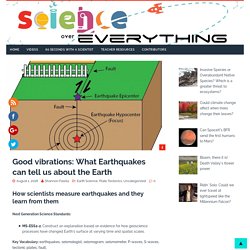
Construct an explanation based on evidence for how geoscience processes have changed Earth’s surface at varying time and spatial scales. Sheets - create and edit spreadsheets online, for free. One account.

All of Google. Sign in to continue to Sheets Find my account Forgot password? SG Analyzing Visual Representations Tsunamis. California Academy of Sciences. New Zealand earthquake lifts the seabed by more than a METRE. These incredible photographs show how New Zealand's 7.8 magnitude earthquake lifted the seabed two metres - and exploded through the sand.

Dramatic aerial pictures reveal the scale of the devastation caused on the coastline north of Kaikoura, on the country's South Island. Scientists say the seabed lifted an estimated two metres on the foreshore and admit they have never seen anything like it. Free K - 12 Common Core Lesson Plans and Ideas. Shake It Up with Seismographs. From TryEngineering, developed by the IEEE Summary Students in grades 3 – 12 explore how the development of seismographs has helped save lives worldwide by working in teams to design their own seismograph from everyday items, test its ability to record a simulated classroom earthquake, evaluate their results, and report to the class.

Grade Level: 3 – 12 Time: One to two 45-minute sessions Objectives Learn about seismograph technology.Learn about engineering design.Learn about teamwork and problem solving. Learning outcomes. Build an Earthquake-proof Structure. (Activity courtesy of MyScienceBox and Irene Salter).
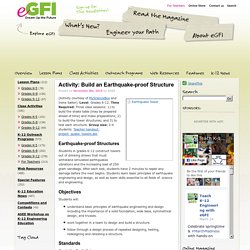
Level: Grades 6-12. Time Required: Three class sessions: 1) to build the shake table (may be prepared ahead of time) and make preparations; 2) to build the tower structures; and 3) to test each structure. Group size: 2-4 students. Teacher handout: project_quake_towers.doc Earthquake-proof Structures Students in grades 6-12 construct towers out of drinking straws that must withstand simulated earthquakes vibrations and the increasing load of 250 gram sandbags. Objectives Students will: understand basic principles of earthquake engineering and design including the importance of a solid foundation, wide base, symmetrical design, and trusses.work together in a team to design and build a structure. follow through a design process of repeated designing, testing, redesigning and retesting a structure. Standards Grade 6 – Earth Science Plate Tectonics and Earth’s Structure 1. D. Shaping Earth’s Surface 2. D. Vocabulary. Locating an Earthquake with Recent Seismic Data- Incorporated Research Institutions for Seismology.
A tremendous number of earthquakes occur every year around the world.
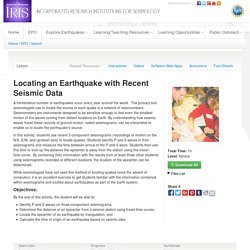
The primary tool seismologists use to locate the source of each quake is a network of seismometers. Seismometers are instruments designed to be sensitive enough to feel even the smallest motion of the waves coming from distant locations on Earth. By understanding how seismic waves travel these records of ground motion, called seismograms, can be interpreted to enable us to locate the earthquake’s source.
In this activity, students use recent 3-component seismograms (recordings of motion on the N/S, E/W, and up/down axis) to locate quakes. Faultline: Earthquake History and Science. Visiting Geoscientist Investigations: Building and Testing Earthquake - Resistant Structures. Preparation Before going to the classroom, you will need to: Contact the teacher to find out the length of the class period, as well as how many copies of handouts and sets of materials you need to bring.
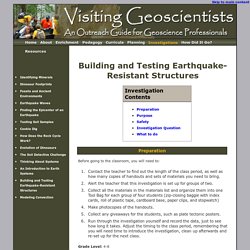
Alert the teacher that this investigation is set up for groups of two. Collect all the materials in the materials list and organize them into one Tool Bag for each group of four students (zip-closing baggie with index cards, roll of plastic tape, cardboard base, paper clips, and stopwatch) Make photocopies of the handouts. Collect any giveaways for the students, such as plate tectonic posters. Natural Disasters - Curricular Unit. Each TeachEngineering lesson or activity is correlated to one or more K-12 science, technology, engineering or math (STEM) educational standards.
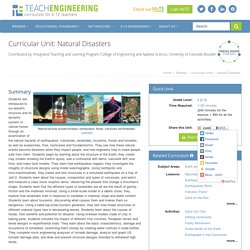
All 100,000+ K-12 STEM standards covered in TeachEngineering are collected, maintained and packaged by the Achievement Standard Network (ASN), a project of JES & Co. (www.jesandco.org). In the ASN, standards are hierarchically structured: first by source; e.g., by state; within source by type; e.g., science or mathematics; within type by subtype, then by grade, etc.
Click on the standard groupings to explore this hierarchy as it applies to this document. All lessons provide a real-world engineering context, helping students understand what engineers study and create to help people live with natural hazards. See individual lessons and activities. QuakeFeed iPhone App. Faultline: Earthquake History and Science. Teaching_strategies. Natural Hazards• ELI Natural Hazards category Plate tectonicsPlate tectonics - whole concept:-• Partial melting - simple process, huge global impact (ELI+)• Partial melting model and real rock (ELI+)• Plate riding (ELI+)• Plate tectonics through the window (ELI+)• Plate margins and movement by hand.
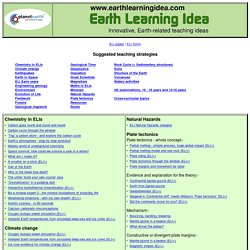
Incorporated Research Institutions for Seismology. Oklahoma earthquakes. Earthquakes may reveal new layer of the Earth: the inner inner core. Though you may be familiar with the phrase “molten core,” the reality is that Earth’s inner core is actually solid, and it’s the outer core that surrounds this enormous ball of heavy metals which remains liquid.

A new study from American and Chinese researchers now posits the existence of an all-new region of the Earth, a distinct core within the inner core — an inner inner core. By studying the propagation of shockwaves from earthquakes around the world, they think they can prove that the iron crystals there are aligned differently than the outer inner core, and that has big implications for our understanding of how the Earth first formed. The solid metal core at the center of the planet formed and cooled to a solid state very (very) slowly. As we find in many chemical processes that proceed so slowly, this slow cooling process allowed the core to form in a very uniform way.
Here’s a simplified look at how researchers interpret seismic wave information. 2nd Biannual NGSS STEM Education Conference. Download the conference schedule and a map Session 1 Arms & Arteries: Adventures in Biomechanical Engineering Looking for ways to integrate engineering into your life science and biology classes? Try biomechanical engineering! Join us as we engineer ways to unclog arteries and construct prosthetic arms while incorporating key scientific principles and NGSS Science & Engineering Practices along the way.
Download Session PDFs.